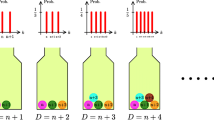Abstract
The Newcomb-Benford distribution of first digits has been applied widely in many areas ranging from engineering to natural and biological sciences for the investigation of self-similarity and randomness. In this article, we consider systems for which the data is not enough to obtain proper first digit statistics, and we propose the use of an iterated version of the distribution where the statistics are aggregated over different scales on grounds that the first digit distribution is approximately scale invariant across a wide range of phenomena, and also because scaling and recomputing first digits is not a linear process. The method presented in this paper generates new data which can be very important for analysis in structured natural systems where data is limited. We provide examples of the use of the iterated test for data in two different biological applications, viz. that of the secretome and the genetic code in both of which the raw data does not include all the nine different first digits. The paper includes proposals for further research on the idea of data amplification using scaling transformations.






Similar content being viewed by others
Data availability
All available data is in the manuscript.
References
Newcomb, S.: Note on the frequency of use of different digits in natural numbers. Am. J. Math. 4, 39–40 (1881)
Benford, F.: The law of anomalous numbers. Proc. Am Philos. Soc. 78(4), 551–572 (1938)
Hill, T.P.: A statistical derivation of the significant-digit law. Stat. Sci. 10, 354–363 (1995)
Hill, T.P.: The first-digit phenomenon. Am. Sci. 86, 358–363 (1998)
Kak, S.: Variations of the Newcomb-Benford law. arXiv (2018). https://arxiv.org/ftp/arxiv/papers/1806/1806.06695.pdf
Sambridge, M., Tkalčić, H., Jackson, A.: Benford’s law in the natural sciences. Geophys. Res. Lett. 37, L22301 (2010)
Prandl, S. et al.: An investigation of power law probability distributions for network anomaly detection. In: IEEE Security and Privacy Workshops (SPW), 217–222 (2017)
Nigrini, M.J., Miller, S.J.: Benford’s law applied to hydrology data—results and relevance to other geophysical data. Math. Geol. 39, 469–490 (2007)
Kak, S.: Power series models of self-similarity in social networks. Inf. Sci. 376, 31–38 (2017)
McCoy, M.M., Allen, A.P., Gilloly, J.F.: The random nature of genome architecture: predicting open reading frame distributions. PLoS ONE 4(7), e6456 (2009)
Friar, J.L., Goldman, T., Perez-Mercader, J.: Genome sizes and the Benford distribution. PLoS ONE 7(5), e36624 (2012)
Kak, S.: Significance testing in natural and biological systems: a review. TechRxiv (2021). https://doi.org/10.36227/techrxiv.14599836.v1
Wong, S.C.Y.: Testing Benford’s Law with the First Two Significant Digits. University of Victoria, Thesis (2010)
Mandelbrot, B.B.: The Fractal Geometry of Nature. Freeman, W. H (1983)
Falconer, K.J.: Fractal Geometry: Mathematical Foundations and Applications. Wiley (2003)
Kak, S.: Information theory and dimensionality of space. Sci. Rep. 10, 20733 (2020)
Kak, S.: The intrinsic dimensionality of data. Circ. Syst. Signal Process. 40, 2599–2607 (2021)
Kak, S.: Fractals with optimum information dimension. Circuits Syst. Signal Process. 40 (2021). https://doi.org/10.1007/s00034-021-01726-5
Kak, S.: The base-e representation of numbers and the power law. Circ. Syst. Signal Process. 40, 490–500 (2021)
Kak, S.: Asymptotic freedom in noninteger spaces. Sci. Rep. 11, 1–5 (2021)
Newman, M.E.J.: Power laws, Pareto distributions and Zipf’s law. Contemp. Phys. 46, 323–351 (2005)
Vicsek, T.: Fluctuations and scaling in biology. Oxford University Press (2001)
Zipf, G.K.: Human Behavior and the Principle of Least Effort. Addison-Wesley, Reading, MA (1949)
Mukherjee, P., Mani, S.: Methodologies to decipher the cell secretome. Biochimica et Biophysica Acta (BBA)—Proteins and Proteomics. 1834(11), 2226–32 (2013)
Uhlén M et al.: Proteomics. Tissue-based map of the human proteome. Science. 347(6220), 1260419 (2015)
Kak, S.: The e-dimensionality of genetic information. TechRxiv (2021). https://doi.org/10.36227/techrxiv.14977479.v1
Crick, F.H.C.: The origin of the genetic code. J. Mol. Biol. 38, 367–379 (1982)
Baranov, P.V., Venin, M., Provan, G.: Codon size reduction as the origin of the triplet genetic code. PLoS ONE 4(5), e5708 (2009)
Attie, O., Sulkow, B., Di, C., Qiu, W.: Genetic codes optimized as a traveling salesman problem. PLoS ONE 14(10), e0224552 (2019)
Salahshour, S., Ahmadian, A., Senu, N., Baleanu, D., Agarwal, P.: On analytical solutions of the fractional differential equation with uncertainty. Entropy 17, 885–902 (2015)
Agarwal, P., Singh, R.: Modelling of transmission dynamics of Nipah virus (Niv): a fractional order approach. Physica A: Statist. Mech. Appl. 547, 124243 (2020)
Yang X.J., Gao F., Srivastava H.M.: A new computational approach for solving nonlinear local fractional PDEs. J. Comput. Appl. Math., 339 (2018)
Funding
Not applicable.
Author information
Authors and Affiliations
Contributions
This represents author’s own work.
Corresponding author
Ethics declarations
Conflict of interest
Not applicable.
Additional information
Publisher's Note
Springer Nature remains neutral with regard to jurisdictional claims in published maps and institutional affiliations.
Rights and permissions
About this article
Cite this article
Kak, S. The Iterated Newcomb-Benford Distribution for Structured Systems. Int. J. Appl. Comput. Math 8, 51 (2022). https://doi.org/10.1007/s40819-022-01251-2
Accepted:
Published:
DOI: https://doi.org/10.1007/s40819-022-01251-2




